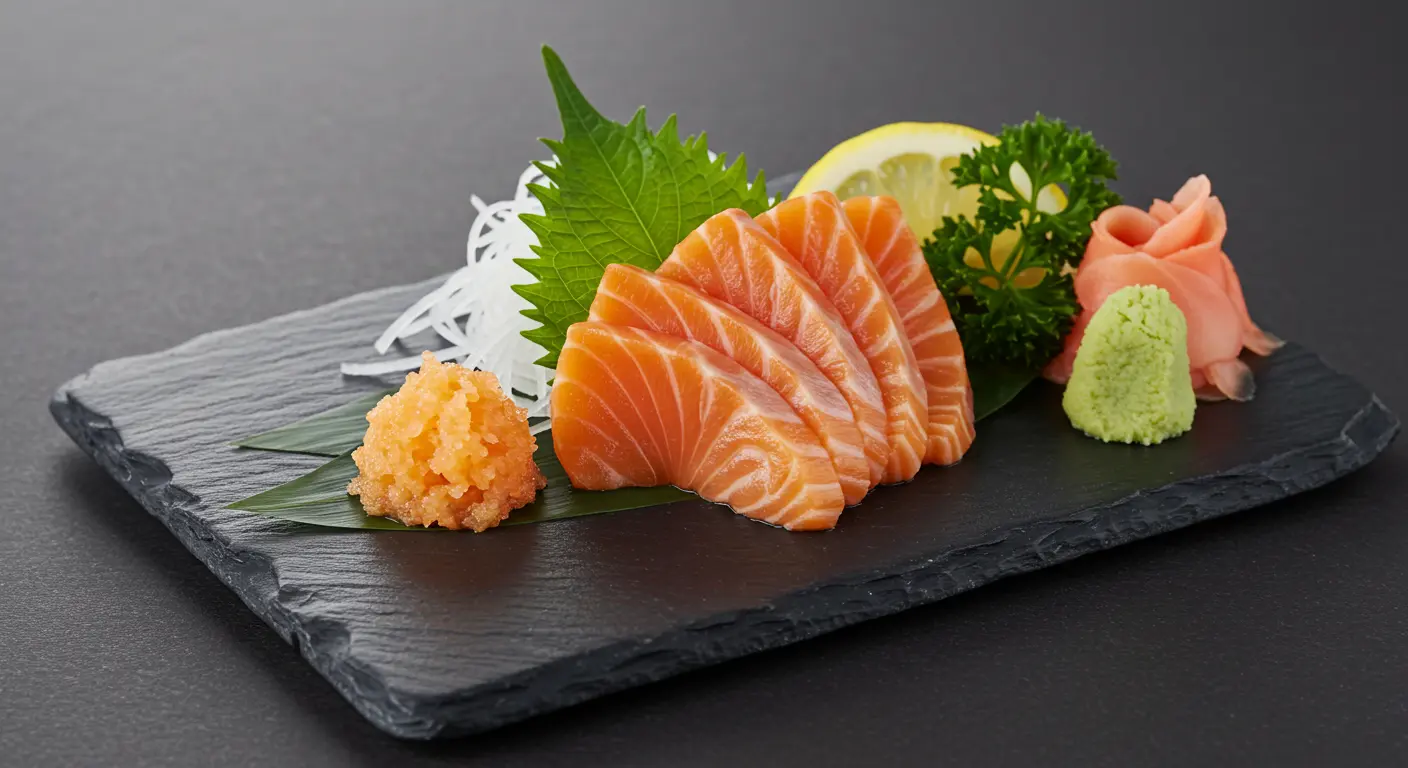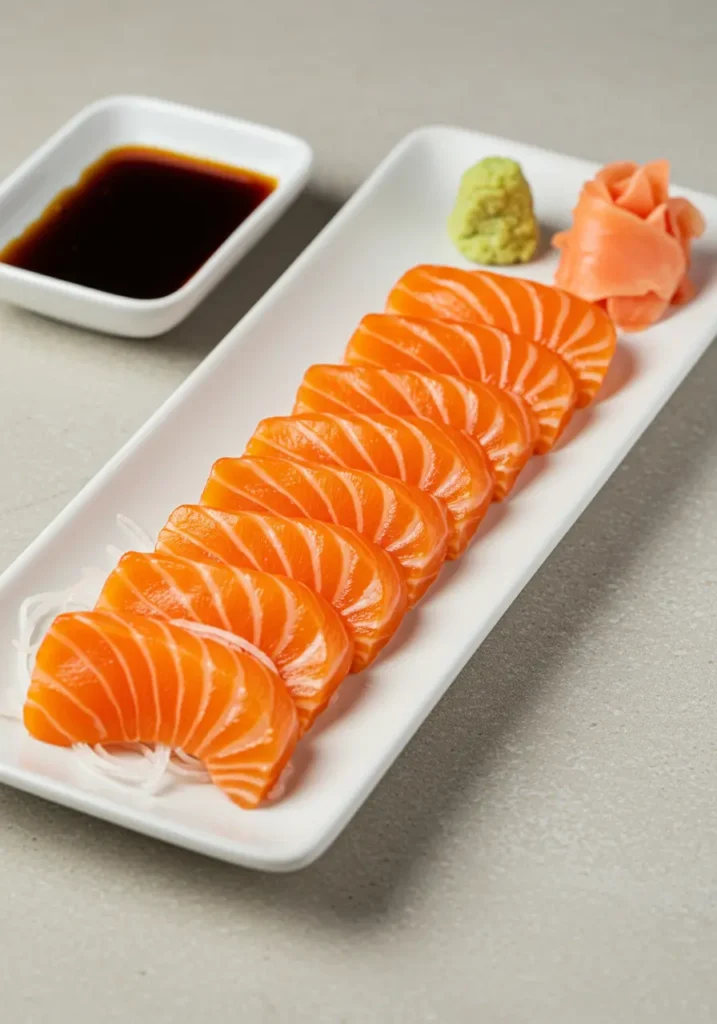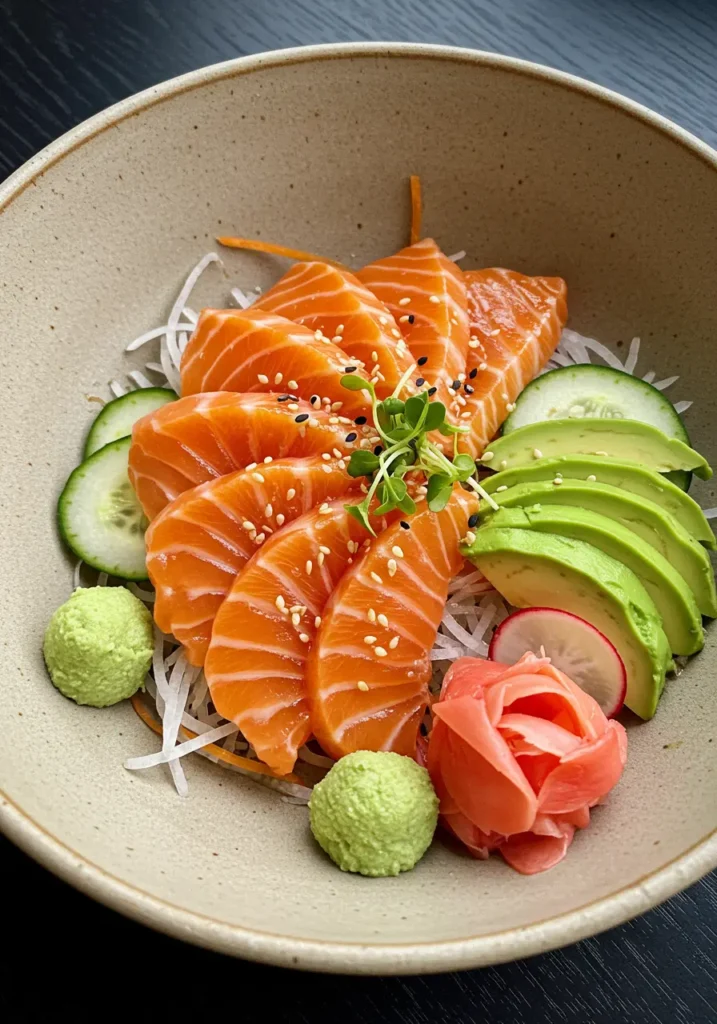Salmon Sashimi 101: Health Benefits and Preparation Tips

Salmon sashimi stands as one of the most beloved delicacies in Japanese cuisine. This raw fish preparation showcases salmon in its purest form, allowing its natural flavors and textures to shine through without the interference of cooking. As interest in Japanese food continues to grow globally, more people are discovering the delights of salmon sashimi, both in restaurants and as a homemade treat.
Table of Contents
What Is Salmon Sashimi?
Salmon sashimi consists of raw salmon sliced into thin, bite-sized pieces. Unlike sushi, which typically includes vinegared rice, sashimi is served on its own, usually accompanied by wasabi, soy sauce, and pickled ginger. The quality of the fish is paramount in sashimi preparation, as there’s nowhere to hide inferior ingredients when serving raw fish.
Salmon Sashimi Nutrition: A Powerhouse of Health Benefits
Salmon sashimi isn’t just delicious; it’s also packed with nutrients that support overall health. Here’s a breakdown of sashimi calories and nutritional benefits:

Nutritional Profile
salmon sashimi calories (per 1 oz / ~28g):
🔸 ~40–50 calories
Typical serving (6 pieces / ~3 oz / ~85g):
🔸 ~120–150 calories
These numbers can vary slightly depending on the fattiness of the salmon (e.g., belly vs. lean cut).
- Protein: 20-25g
- Fat: 4-8g (primarily healthy omega-3 fatty acids)
- Carbohydrates: 0g
Key Health Benefits
Rich in Omega-3 Fatty Acids: Salmon is one of the best sources of EPA and DHA, omega-3 fatty acids that support heart and brain health.
High-Quality Protein: Sashimi provides complete protein containing all essential amino acids necessary for muscle maintenance and growth.
Vitamin D Source: Often called the “sunshine vitamin,” vitamin D aids calcium absorption and supports immune function. Salmon is one of the few natural food sources of this vital nutrient.
B Vitamin Complex: Salmon contains several B vitamins, including B12, niacin, and B6, which support energy production, brain function, and cell health.
Minerals: Provides selenium, potassium, and phosphorus, which support various bodily functions from thyroid health to bone strength.
Antioxidants: Contains the powerful antioxidant astaxanthin, which gives salmon its pink color and provides anti-inflammatory benefits.
Low in Contaminants: When sourced properly, sashimi can be lower in environmental contaminants compared to larger predatory fish.
Salmon Sashimi Recipe: Preparing Perfect Sashimi at Home

Creating restaurant-quality sashimi at home is possible with careful attention to sourcing, preparation, and presentation. Follow these steps for the best results:
Ingredients
- 1/2 pound sashimi-grade salmon
- Soy sauce for dipping
- Wasabi paste
- Pickled ginger
- Optional garnishes: thinly sliced scallions, sesame seeds, microgreens
Equipment
- Sharp knife (preferably a sashimi knife)
- Cutting board
- Paper towels
Step-by-Step Instructions
Source High-Quality Fish: Purchase sashimi-grade salmon from a reputable fishmonger or Japanese market. This grade is specifically handled for raw consumption.
Safety Preparation: If you’re concerned about parasites, freeze the salmon at -4°F (-20°C) for at least 24 hours, then thaw it overnight in the refrigerator.
Prepare the Salmon:
- Remove the salmon from refrigeration 20 minutes before slicing
- Rinse briefly under cold water and pat completely dry with paper towels
- Remove any skin and trim away dark areas of flesh
Slice the Salmon:
- Using a very sharp knife, cut the salmon against the grain
- Aim for slices about 1/4 inch thick and 2 inches long
- Clean your knife with a damp cloth between cuts for the cleanest slices
Arrange and Serve:
- Place slices on a chilled plate in an attractive pattern
- Serve immediately with small dishes of soy sauce and wasabi
- Add pickled ginger on the side
- Garnish with thinly sliced scallions or sesame seeds if desired
Tips for the Best Sashimi Salmon Experience
- Quality Matters: Never compromise on fish quality when preparing sashimi. Always use sashimi-grade salmon from trusted sources.
- Temperature Control: Keep salmon well-refrigerated until shortly before serving. Serve on chilled plates for the best texture and flavor.
- Knife Skills: Invest in a proper sashimi knife if you plan to make sashimi regularly. The clean cuts make a significant difference in texture.
- Eat Fresh: Consume sashimi within 24 hours of purchase, ideally the same day.
- Proper Accompaniments: High-quality soy sauce and fresh wasabi (not the powdered kind if possible) enhance the sashimi experience.
- Simple Presentation: Let the beauty of the fish speak for itself with minimal but thoughtful plating.
Safety Considerations
When enjoying salmon sashimi, certain safety precautions should be observed:
- Always purchase from reputable sources that specialize in sashimi-grade fish
- Keep raw fish refrigerated at all times until preparation
- Consume within 24 hours of purchase
- Those with compromised immune systems, pregnant women, young children, and the elderly should consult with a healthcare provider before consuming raw fish
- Use separate cutting boards and utensils for raw fish preparation
VARIATIONS AND CUSTOMIZATIONS

Seasonal Adaptations
Salmon sashimi can be enhanced with seasonal touches throughout the year. In spring, pair your sashimi with fresh microgreens or a light yuzu-infused dressing. Summer calls for refreshing additions like cucumber ribbons, thinly sliced ripe avocado, or a light citrus zest. During fall, incorporate thinly sliced persimmons or a drizzle of pomegranate reduction for a sweet-tart contrast. Winter preparations benefit from warming elements like a light brush of miso glaze or a sprinkle of toasted sesame seeds. Consider matching your presentation to the season as well—lighter, brighter arrangements for warm months and more substantial presentations during colder seasons.
Dietary Modifications
While traditional salmon sashimi is naturally gluten-free, be cautious with accompaniments. Replace standard soy sauce with tamari or certified gluten-free soy sauce for those with gluten sensitivities. For paleo or keto diets, sashimi is an excellent choice—simply avoid sugar-containing dipping sauces and opt for coconut aminos instead of soy sauce if desired. Though traditional sashimi cannot be made vegan, plant-based eaters can enjoy carrot “salmon” sashimi made by thinly slicing carrots and marinating them in a mixture of liquid smoke, soy sauce, rice vinegar, and kelp powder to create a surprisingly similar flavor profile and texture.
Flavor Variations
Beyond traditional preparations, salmon sashimi can be elevated with various flavor profiles. For a Scandinavian twist, serve with a light dill oil, tiny dots of mustard, and thinly sliced radishes. Create a Latin-inspired version with a light cilantro-lime dressing, thin jalapeño slices, and a sprinkle of sea salt. For an Asian fusion approach, try drizzling with a light coconut-lemongrass sauce and topping with crispy fried shallots. A modern variation includes lightly torching the top of the salmon sashimi for a hint of smoky flavor while keeping the inside raw. For special occasions, consider adding a small amount of premium ingredients like truffle oil, sturgeon caviar, or gold leaf for an elegant, luxurious presentation.
Conclusion
Salmon sashimi offers a perfect blend of culinary delight and nutritional benefits. With its rich omega-3 content, impressive protein profile, and array of vitamins and minerals, it’s a healthful choice for seafood enthusiasts. By following proper sourcing and preparation techniques, you can enjoy this Japanese delicacy safely at home, appreciating both its subtle flavors and substantial health benefits.
Whether you’re a longtime fan or new to the world of raw fish preparations, salmon sashimi provides an accessible entry point to Japanese cuisine that can be both a sensory pleasure and a nutritious addition to your diet.
Frequently Asked Questions About Salmon Sashimi
Is it safe to eat salmon sashimi?
Yes, salmon sashimi is safe to eat when properly sourced and prepared. Always purchase sashimi-grade salmon from reputable fishmongers or Japanese markets. This grade is specifically handled for raw consumption and undergoes flash-freezing to kill potential parasites. If preparing at home, freezing at -4°F (-20°C) for at least 24 hours before consumption adds an extra layer of safety.
What’s the difference between salmon sashimi and salmon sushi?
The main difference is that sashimi consists of just raw sliced salmon served without rice, while salmon sushi includes vinegared rice. Sashimi focuses entirely on the pure flavor of the fish itself, whereas sushi combines the fish with seasoned rice and sometimes other ingredients.
How many calories are in salmon sashimi?
Sashimi contains approximately 130-150 calories per 100g serving. It’s relatively low in calories compared to many other protein sources, making it a good option for those monitoring their caloric intake while still getting high-quality nutrition.
Can I make salmon sashimi from any salmon?
No, not all salmon is suitable for sashimi. You should only use sashimi-grade salmon (sometimes labeled as “sushi-grade”) that has been properly handled for raw consumption. Regular grocery store salmon is generally not considered safe for raw consumption unless specifically labeled for this purpose.
How long does salmon sashimi last?
Salmon sashimi should be consumed within 24 hours of purchase, ideally the same day. Once prepared and sliced, it should be eaten within 2 hours if kept at room temperature, or up to 4 hours if refrigerated. Never leave sashimi out at room temperature for extended periods.
What is the best type of salmon for sashimi?
Farmed Atlantic salmon is commonly used for sashimi due to its consistent quality and lower parasite risk compared to wild salmon. However, wild salmon varieties like sockeye or king salmon can offer more complex flavors when properly prepared. The most important factor is ensuring it’s sashimi-grade regardless of the variety.
Can pregnant women eat salmon sashimi?
Most health authorities, including the FDA and CDC, advise pregnant women to avoid raw fish, including salmon sashimi, due to the risk of foodborne illness and parasites that could harm the developing baby. Pregnant women should consult with their healthcare provider for personalized advice.
What do you eat with salmon sashimi?
Traditionally, salmon sashimi is served with wasabi, soy sauce, and pickled ginger (gari). You can also add a small amount of freshly grated daikon radish, a sprinkle of lemon juice, or a light ponzu sauce. Keep accompaniments simple to allow the natural flavor of the salmon to shine.
Does freezing salmon affect the texture for sashimi?
Proper flash-freezing techniques used commercially have minimal impact on texture. However, home freezing may slightly alter the texture depending on your freezer’s capability. For the best texture, consume commercially frozen sashimi-grade salmon that has been properly thawed in the refrigerator overnight.
What are the health benefits of eating salmon sashimi?
Salmon sashimi is rich in omega-3 fatty acids, high-quality protein, vitamin D, B vitamins, and minerals like selenium. These nutrients support heart health, brain function, and anti-inflammatory processes in the body. As it’s consumed raw, it also retains all of its natural nutrients without any loss from cooking.
